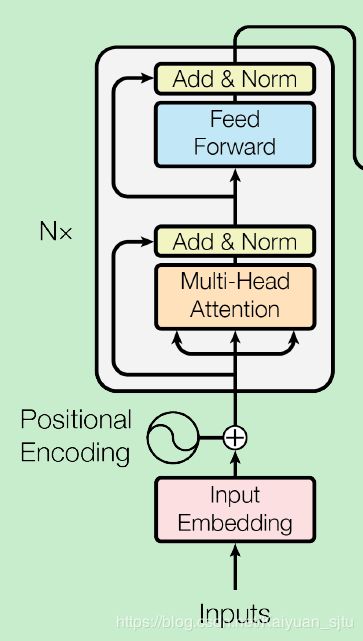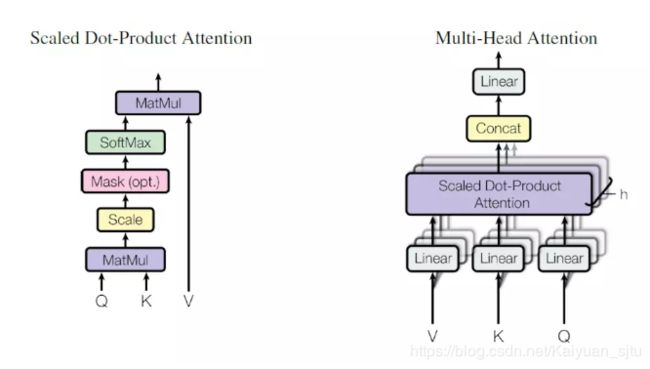BERT源码分析(PART I)
写在前面
[email protected]
最近在看paddle相关,于是就打算仔细过一遍百度ERNIE的源码。之前粗看的时候还没有ERNIE2.0、ERNIE-tiny,整体感觉跟BERT也挺类似的,不知道更新了之后会是啥样~看完也会整理跟下面类似的总结,刚好也在研究paddle或ERNIE的同学可以加我一起讨论哈哈哈
原内容@2019.05.16
BERT 模型也出来很久了, 之前有看过论文和一些博客对其做了解读:NLP 大杀器 BERT 模型解读[1],但是一直没有细致地去看源码具体实现。最近有用到就抽时间来仔细看看记录下来,和大家一起讨论。
注意,源码阅读系列需要提前对 NLP 相关知识有所了解,比如 attention 机制、transformer 框架以及 python 和 tensorflow 基础等,关于 BERT 的原理不是本文的重点。
附上关于 BERT 的资料汇总:BERT 相关论文、文章和代码资源汇总[2]
今天要介绍的是 BERT 最主要的模型实现部分-----BertModel,代码位于
modeling.py 模块[3]
除了代码块外部,在代码块内部也有注释噢
如有解读不正确,请务必指出~
1、配置类(BertConfig)
这部分代码主要定义了 BERT 模型的一些默认参数,另外包括了一些文件处理函数。
class BertConfig(object):
"""BERT模型的配置类."""
def __init__(self,
vocab_size,
hidden_size=768,
num_hidden_layers=12,
num_attention_heads=12,
intermediate_size=3072,
hidden_act="gelu",
hidden_dropout_prob=0.1,
attention_probs_dropout_prob=0.1,
max_position_embeddings=512,
type_vocab_size=16,
initializer_range=0.02):
self.vocab_size = vocab_size
self.hidden_size = hidden_size
self.num_hidden_layers = num_hidden_layers
self.num_attention_heads = num_attention_heads
self.hidden_act = hidden_act
self.intermediate_size = intermediate_size
self.hidden_dropout_prob = hidden_dropout_prob
self.attention_probs_dropout_prob = attention_probs_dropout_prob
self.max_position_embeddings = max_position_embeddings
self.type_vocab_size = type_vocab_size
self.initializer_range = initializer_range
@classmethod
def from_dict(cls, json_object):
"""Constructs a `BertConfig` from a Python dictionary of parameters."""
config = BertConfig(vocab_size=None)
for (key, value) in six.iteritems(json_object):
config.__dict__[key] = value
return config
@classmethod
def from_json_file(cls, json_file):
"""Constructs a `BertConfig` from a json file of parameters."""
with tf.gfile.GFile(json_file, "r") as reader:
text = reader.read()
return cls.from_dict(json.loads(text))
def to_dict(self):
"""Serializes this instance to a Python dictionary."""
output = copy.deepcopy(self.__dict__)
return output
def to_json_string(self):
"""Serializes this instance to a JSON string."""
return json.dumps(self.to_dict(), indent=2, sort_keys=True) + "\n"
「参数具体含义」
vocab_size:词表大小
hidden_size:隐藏层神经元数
num_hidden_layers:Transformer encoder 中的隐藏层数
*num_attention_heads:*multi-head attention 的 head 数
intermediate_size:encoder 的“中间”隐层神经元数(例如 feed-forward layer)
hidden_act:隐藏层激活函数
hidden_dropout_prob:隐层 dropout 率
attention_probs_dropout_prob:注意力部分的 dropout
max_position_embeddings:最大位置编码
type_vocab_size:token_type_ids 的词典大小
initializer_range:truncated_normal_initializer 初始化方法的 stdev
这里要注意一点,可能刚看的时候对type_vocab_size这个参数会有点不理解,其实就是在next sentence prediction任务里的Segment A和 Segment B。在下载的bert_config.json文件里也有说明,默认值应该为 2。参考这个 Issue[4]
2、获取词向量(Embedding_lookup)
对于输入 word_ids,返回 embedding table。可以选用 one-hot 或者 tf.gather()
def embedding_lookup(input_ids, # word_id:【batch_size, seq_length】
vocab_size,
embedding_size=128,
initializer_range=0.02,
word_embedding_name="word_embeddings",
use_one_hot_embeddings=False):
# 该函数默认输入的形状为【batch_size, seq_length, input_num】
# 如果输入为2D的【batch_size, seq_length】,则扩展到【batch_size, seq_length, 1】
if input_ids.shape.ndims == 2:
input_ids = tf.expand_dims(input_ids, axis=[-1])
embedding_table = tf.get_variable(
name=word_embedding_name,
shape=[vocab_size, embedding_size],
initializer=create_initializer(initializer_range))
flat_input_ids = tf.reshape(input_ids, [-1]) #【batch_size*seq_length*input_num】
if use_one_hot_embeddings:
one_hot_input_ids = tf.one_hot(flat_input_ids, depth=vocab_size)
output = tf.matmul(one_hot_input_ids, embedding_table)
else: # 按索引取值
output = tf.gather(embedding_table, flat_input_ids)
input_shape = get_shape_list(input_ids)
# output:[batch_size, seq_length, num_inputs]
# 转成:[batch_size, seq_length, num_inputs*embedding_size]
output = tf.reshape(output,
input_shape[0:-1] + [input_shape[-1] * embedding_size])
return (output, embedding_table)
「参数具体含义」
input_ids:word id 【batch_size, seq_length】
vocab_size:embedding 词表
embedding_size:embedding 维度
initializer_range:embedding 初始化范围
word_embedding_name:embeddding table 命名
use_one_hot_embeddings:是否使用 one-hotembedding
Return:【batch_size, seq_length, embedding_size】
3、词向量的后续处理(embedding_postprocessor)
我们知道 BERT 模型的输入有三部分:token embedding ,segment embedding以及position embedding。上一节中我们只获得了 token embedding,这部分代码对其完善信息,正则化,dropout 之后输出最终 embedding。注意,在 Transformer 论文中的position embedding是由 sin/cos 函数生成的固定的值,而在这里代码实现中是跟普通 word embedding 一样随机生成的,可以训练的。作者这里这样选择的原因可能是 BERT 训练的数据比 Transformer 那篇大很多,完全可以让模型自己去学习。
def embedding_postprocessor(input_tensor, # [batch_size, seq_length, embedding_size]
use_token_type=False,
token_type_ids=None,
token_type_vocab_size=16, # 一般是2
token_type_embedding_name="token_type_embeddings",
use_position_embeddings=True,
position_embedding_name="position_embeddings",
initializer_range=0.02,
max_position_embeddings=512, #最大位置编码,必须大于等于max_seq_len
dropout_prob=0.1):
input_shape = get_shape_list(input_tensor, expected_rank=3) #【batch_size,seq_length,embedding_size】
batch_size = input_shape[0]
seq_length = input_shape[1]
width = input_shape[2]
output = input_tensor
# Segment position信息
if use_token_type:
if token_type_ids is None:
raise ValueError("`token_type_ids` must be specified if"
"`use_token_type` is True.")
token_type_table = tf.get_variable(
name=token_type_embedding_name,
shape=[token_type_vocab_size, width],
initializer=create_initializer(initializer_range))
# 由于token-type-table比较小,所以这里采用one-hot的embedding方式加速
flat_token_type_ids = tf.reshape(token_type_ids, [-1])
one_hot_ids = tf.one_hot(flat_token_type_ids, depth=token_type_vocab_size)
token_type_embeddings = tf.matmul(one_hot_ids, token_type_table)
token_type_embeddings = tf.reshape(token_type_embeddings,
[batch_size, seq_length, width])
output += token_type_embeddings
# Position embedding信息
if use_position_embeddings:
# 确保seq_length小于等于max_position_embeddings
assert_op = tf.assert_less_equal(seq_length, max_position_embeddings)
with tf.control_dependencies([assert_op]):
full_position_embeddings = tf.get_variable(
name=position_embedding_name,
shape=[max_position_embeddings, width],
initializer=create_initializer(initializer_range))
# 这里position embedding是可学习的参数,[max_position_embeddings, width]
# 但是通常实际输入序列没有达到max_position_embeddings
# 所以为了提高训练速度,使用tf.slice取出句子长度的embedding
position_embeddings = tf.slice(full_position_embeddings, [0, 0],
[seq_length, -1])
num_dims = len(output.shape.as_list())
# word embedding之后的tensor是[batch_size, seq_length, width]
# 因为位置编码是与输入内容无关,它的shape总是[seq_length, width]
# 我们无法把位置Embedding加到word embedding上
# 因此我们需要扩展位置编码为[1, seq_length, width]
# 然后就能通过broadcasting加上去了。
position_broadcast_shape = []
for _ in range(num_dims - 2):
position_broadcast_shape.append(1)
position_broadcast_shape.extend([seq_length, width])
position_embeddings = tf.reshape(position_embeddings,
position_broadcast_shape)
output += position_embeddings
output = layer_norm_and_dropout(output, dropout_prob)
return output
4、构造 attention_mask
该部分代码的作用是构造 attention 可视域的 attention_mask, 因为每个样本都经过 padding 过程,在做self-attention的是padding的部分不能attend到其他部分上。输入为形状为 [batch_size, from_seq_length,...] 的 padding 好的 input_ids 和形状为 [batch_size, to_seq_length] 的 mask 标记向量。
def create_attention_mask_from_input_mask(from_tensor, to_mask):
from_shape = get_shape_list(from_tensor, expected_rank=[2, 3])
batch_size = from_shape[0]
from_seq_length = from_shape[1]
to_shape = get_shape_list(to_mask, expected_rank=2)
to_seq_length = to_shape[1]
to_mask = tf.cast(
tf.reshape(to_mask, [batch_size, 1, to_seq_length]), tf.float32)
broadcast_ones = tf.ones(
shape=[batch_size, from_seq_length, 1], dtype=tf.float32)
mask = broadcast_ones * to_mask
return mask
5、注意力层(attention layer)
这部分代码是「multi-head attention」的实现,主要来自《Attention is all you need》这篇论文。考虑key-query-value形式的 attention,输入的from_tensor当做是 query, to_tensor当做是 key 和 value,当两者相同的时候即为 self-attention。关于 attention 更详细的介绍可以转到【理解 Attention 机制原理及模型[5]】。
def attention_layer(from_tensor, # 【batch_size, from_seq_length, from_width】
to_tensor, #【batch_size, to_seq_length, to_width】
attention_mask=None, #【batch_size,from_seq_length, to_seq_length】
num_attention_heads=1, # attention head numbers
size_per_head=512, # 每个head的大小
query_act=None, # query变换的激活函数
key_act=None, # key变换的激活函数
value_act=None, # value变换的激活函数
attention_probs_dropout_prob=0.0, # attention层的dropout
initializer_range=0.02, # 初始化取值范围
do_return_2d_tensor=False, # 是否返回2d张量。
#如果True,输出形状【batch_size*from_seq_length,num_attention_heads*size_per_head】
#如果False,输出形状【batch_size, from_seq_length, num_attention_heads*size_per_head】
batch_size=None, #如果输入是3D的,
#那么batch就是第一维,但是可能3D的压缩成了2D的,所以需要告诉函数batch_size
from_seq_length=None, # 同上
to_seq_length=None): # 同上
def transpose_for_scores(input_tensor, batch_size, num_attention_heads,
seq_length, width):
output_tensor = tf.reshape(
input_tensor, [batch_size, seq_length, num_attention_heads, width])
output_tensor = tf.transpose(output_tensor, [0, 2, 1, 3]) #[batch_size, num_attention_heads, seq_length, width]
return output_tensor
from_shape = get_shape_list(from_tensor, expected_rank=[2, 3])
to_shape = get_shape_list(to_tensor, expected_rank=[2, 3])
if len(from_shape) != len(to_shape):
raise ValueError(
"The rank of `from_tensor` must match the rank of `to_tensor`.")
if len(from_shape) == 3:
batch_size = from_shape[0]
from_seq_length = from_shape[1]
to_seq_length = to_shape[1]
elif len(from_shape) == 2:
if (batch_size is None or from_seq_length is None or to_seq_length is None):
raise ValueError(
"When passing in rank 2 tensors to attention_layer, the values "
"for `batch_size`, `from_seq_length`, and `to_seq_length` "
"must all be specified.")
# 为了方便备注shape,采用以下简写:
# B = batch size (number of sequences)
# F = `from_tensor` sequence length
# T = `to_tensor` sequence length
# N = `num_attention_heads`
# H = `size_per_head`
# 把from_tensor和to_tensor压缩成2D张量
from_tensor_2d = reshape_to_matrix(from_tensor) # 【B*F, hidden_size】
to_tensor_2d = reshape_to_matrix(to_tensor) # 【B*T, hidden_size】
# 将from_tensor输入全连接层得到query_layer
# `query_layer` = [B*F, N*H]
query_layer = tf.layers.dense(
from_tensor_2d,
num_attention_heads * size_per_head,
activation=query_act,
name="query",
kernel_initializer=create_initializer(initializer_range))
# 将from_tensor输入全连接层得到query_layer
# `key_layer` = [B*T, N*H]
key_layer = tf.layers.dense(
to_tensor_2d,
num_attention_heads * size_per_head,
activation=key_act,
name="key",
kernel_initializer=create_initializer(initializer_range))
# 同上
# `value_layer` = [B*T, N*H]
value_layer = tf.layers.dense(
to_tensor_2d,
num_attention_heads * size_per_head,
activation=value_act,
name="value",
kernel_initializer=create_initializer(initializer_range))
# query_layer转成多头:[B*F, N*H]==>[B, F, N, H]==>[B, N, F, H]
query_layer = transpose_for_scores(query_layer, batch_size,
num_attention_heads, from_seq_length,
size_per_head)
# key_layer转成多头:[B*T, N*H] ==> [B, T, N, H] ==> [B, N, T, H]
key_layer = transpose_for_scores(key_layer, batch_size, num_attention_heads,
to_seq_length, size_per_head)
# 将query与key做点积,然后做一个scale,公式可以参见原始论文
# `attention_scores` = [B, N, F, T]
attention_scores = tf.matmul(query_layer, key_layer, transpose_b=True)
attention_scores = tf.multiply(attention_scores,
1.0 / math.sqrt(float(size_per_head)))
if attention_mask is not None:
# `attention_mask` = [B, 1, F, T]
attention_mask = tf.expand_dims(attention_mask, axis=[1])
# 如果attention_mask里的元素为1,则通过下面运算有(1-1)*-10000,adder就是0
# 如果attention_mask里的元素为0,则通过下面运算有(1-0)*-10000,adder就是-10000
adder = (1.0 - tf.cast(attention_mask, tf.float32)) * -10000.0
# 我们最终得到的attention_score一般不会很大,
#所以上述操作对mask为0的地方得到的score可以认为是负无穷
attention_scores += adder
# 负无穷经过softmax之后为0,就相当于mask为0的位置不计算attention_score
# `attention_probs` = [B, N, F, T]
attention_probs = tf.nn.softmax(attention_scores)
# 对attention_probs进行dropout,这虽然有点奇怪,但是Transforme原始论文就是这么做的
attention_probs = dropout(attention_probs, attention_probs_dropout_prob)
# `value_layer` = [B, T, N, H]
value_layer = tf.reshape(
value_layer,
[batch_size, to_seq_length, num_attention_heads, size_per_head])
# `value_layer` = [B, N, T, H]
value_layer = tf.transpose(value_layer, [0, 2, 1, 3])
# `context_layer` = [B, N, F, H]
context_layer = tf.matmul(attention_probs, value_layer)
# `context_layer` = [B, F, N, H]
context_layer = tf.transpose(context_layer, [0, 2, 1, 3])
if do_return_2d_tensor:
# `context_layer` = [B*F, N*H]
context_layer = tf.reshape(
context_layer,
[batch_size * from_seq_length, num_attention_heads * size_per_head])
else:
# `context_layer` = [B, F, N*H]
context_layer = tf.reshape(
context_layer,
[batch_size, from_seq_length, num_attention_heads * size_per_head])
return context_layer
总结一下,attention layer 的主要流程:
对输入的 tensor 进行形状校验,提取
batch_size、from_seq_length 、to_seq_length;输入如果是 3d 张量则转化成 2d 矩阵;
from_tensor 作为 query, to_tensor 作为 key 和 value,经过一层全连接层后得到 query_layer、key_layer 、value_layer;
将上述张量通过
transpose_for_scores转化成 multi-head;根据论文公式计算 attention_score 以及 attention_probs(注意 attention_mask 的 trick):
6、Transformer
接下来的代码就是大名鼎鼎的 Transformer 的核心代码了,可以认为是"Attention is All You Need"原始代码重现。可以参见【原始论文[6]】和【原始代码[7]】。
def transformer_model(input_tensor, # 【batch_size, seq_length, hidden_size】
attention_mask=None, # 【batch_size, seq_length, seq_length】
hidden_size=768,
num_hidden_layers=12,
num_attention_heads=12,
intermediate_size=3072,
intermediate_act_fn=gelu, # feed-forward层的激活函数
hidden_dropout_prob=0.1,
attention_probs_dropout_prob=0.1,
initializer_range=0.02,
do_return_all_layers=False):
# 这里注意,因为最终要输出hidden_size, 我们有num_attention_head个区域,
# 每个head区域有size_per_head多的隐层
# 所以有 hidden_size = num_attention_head * size_per_head
if hidden_size % num_attention_heads != 0:
raise ValueError(
"The hidden size (%d) is not a multiple of the number of attention "
"heads (%d)" % (hidden_size, num_attention_heads))
attention_head_size = int(hidden_size / num_attention_heads)
input_shape = get_shape_list(input_tensor, expected_rank=3)
batch_size = input_shape[0]
seq_length = input_shape[1]
input_width = input_shape[2]
# 因为encoder中有残差操作,所以需要shape相同
if input_width != hidden_size:
raise ValueError("The width of the input tensor (%d) != hidden size (%d)" %
(input_width, hidden_size))
# reshape操作在CPU/GPU上很快,但是在TPU上很不友好
# 所以为了避免2D和3D之间的频繁reshape,我们把所有的3D张量用2D矩阵表示
prev_output = reshape_to_matrix(input_tensor)
all_layer_outputs = []
for layer_idx in range(num_hidden_layers):
with tf.variable_scope("layer_%d" % layer_idx):
layer_input = prev_output
with tf.variable_scope("attention"):
# multi-head attention
attention_heads = []
with tf.variable_scope("self"):
# self-attention
attention_head = attention_layer(
from_tensor=layer_input,
to_tensor=layer_input,
attention_mask=attention_mask,
num_attention_heads=num_attention_heads,
size_per_head=attention_head_size,
attention_probs_dropout_prob=attention_probs_dropout_prob,
initializer_range=initializer_range,
do_return_2d_tensor=True,
batch_size=batch_size,
from_seq_length=seq_length,
to_seq_length=seq_length)
attention_heads.append(attention_head)
attention_output = None
if len(attention_heads) == 1:
attention_output = attention_heads[0]
else:
# 如果有多个head,将他们拼接起来
attention_output = tf.concat(attention_heads, axis=-1)
# 对attention的输出进行线性映射, 目的是将shape变成与input一致
# 然后dropout+residual+norm
with tf.variable_scope("output"):
attention_output = tf.layers.dense(
attention_output,
hidden_size,
kernel_initializer=create_initializer(initializer_range))
attention_output = dropout(attention_output, hidden_dropout_prob)
attention_output = layer_norm(attention_output + layer_input)
# feed-forward
with tf.variable_scope("intermediate"):
intermediate_output = tf.layers.dense(
attention_output,
intermediate_size,
activation=intermediate_act_fn,
kernel_initializer=create_initializer(initializer_range))
# 对feed-forward层的输出使用线性变换变回‘hidden_size’
# 然后dropout + residual + norm
with tf.variable_scope("output"):
layer_output = tf.layers.dense(
intermediate_output,
hidden_size,
kernel_initializer=create_initializer(initializer_range))
layer_output = dropout(layer_output, hidden_dropout_prob)
layer_output = layer_norm(layer_output + attention_output)
prev_output = layer_output
all_layer_outputs.append(layer_output)
if do_return_all_layers:
final_outputs = []
for layer_output in all_layer_outputs:
final_output = reshape_from_matrix(layer_output, input_shape)
final_outputs.append(final_output)
return final_outputs
else:
final_output = reshape_from_matrix(prev_output, input_shape)
return final_output
配上下图一同使用效果更佳,因为 BERT 里只有 encoder,所有 decoder 没有姓名
7、函数入口(init)
BertModel 类的构造函数,有了上面几节的铺垫,我们就可以来实现 BERT 模型了。
def __init__(self,
config, # BertConfig对象
is_training,
input_ids, # 【batch_size, seq_length】
input_mask=None, # 【batch_size, seq_length】
token_type_ids=None, # 【batch_size, seq_length】
use_one_hot_embeddings=False, # 是否使用one-hot;否则tf.gather()
scope=None):
config = copy.deepcopy(config)
if not is_training:
config.hidden_dropout_prob = 0.0
config.attention_probs_dropout_prob = 0.0
input_shape = get_shape_list(input_ids, expected_rank=2)
batch_size = input_shape[0]
seq_length = input_shape[1]
# 不做mask,即所有元素为1
if input_mask is None:
input_mask = tf.ones(shape=[batch_size, seq_length], dtype=tf.int32)
if token_type_ids is None:
token_type_ids = tf.zeros(shape=[batch_size, seq_length], dtype=tf.int32)
with tf.variable_scope(scope, default_name="bert"):
with tf.variable_scope("embeddings"):
# word embedding
(self.embedding_output, self.embedding_table) = embedding_lookup(
input_ids=input_ids,
vocab_size=config.vocab_size,
embedding_size=config.hidden_size,
initializer_range=config.initializer_range,
word_embedding_name="word_embeddings",
use_one_hot_embeddings=use_one_hot_embeddings)
# 添加position embedding和segment embedding
# layer norm + dropout
self.embedding_output = embedding_postprocessor(
input_tensor=self.embedding_output,
use_token_type=True,
token_type_ids=token_type_ids,
token_type_vocab_size=config.type_vocab_size,
token_type_embedding_name="token_type_embeddings",
use_position_embeddings=True,
position_embedding_name="position_embeddings",
initializer_range=config.initializer_range,
max_position_embeddings=config.max_position_embeddings,
dropout_prob=config.hidden_dropout_prob)
with tf.variable_scope("encoder"):
# input_ids是经过padding的word_ids:[25, 120, 34, 0, 0]
# input_mask是有效词标记:[1, 1, 1, 0, 0]
attention_mask = create_attention_mask_from_input_mask(
input_ids, input_mask)
# transformer模块叠加
# `sequence_output` shape = [batch_size, seq_length, hidden_size].
self.all_encoder_layers = transformer_model(
input_tensor=self.embedding_output,
attention_mask=attention_mask,
hidden_size=config.hidden_size,
num_hidden_layers=config.num_hidden_layers,
num_attention_heads=config.num_attention_heads,
intermediate_size=config.intermediate_size,
intermediate_act_fn=get_activation(config.hidden_act),
hidden_dropout_prob=config.hidden_dropout_prob,
attention_probs_dropout_prob=config.attention_probs_dropout_prob,
initializer_range=config.initializer_range,
do_return_all_layers=True)
# `self.sequence_output`是最后一层的输出,shape为【batch_size, seq_length, hidden_size】
self.sequence_output = self.all_encoder_layers[-1]
# ‘pooler’部分将encoder输出【batch_size, seq_length, hidden_size】
# 转成【batch_size, hidden_size】
with tf.variable_scope("pooler"):
# 取最后一层的第一个时刻[CLS]对应的tensor, 对于分类任务很重要
# sequence_output[:, 0:1, :]得到的是[batch_size, 1, hidden_size]
# 我们需要用squeeze把第二维去掉
first_token_tensor = tf.squeeze(self.sequence_output[:, 0:1, :], axis=1)
# 然后再加一个全连接层,输出仍然是[batch_size, hidden_size]
self.pooled_output = tf.layers.dense(
first_token_tensor,
config.hidden_size,
activation=tf.tanh,
kernel_initializer=create_initializer(config.initializer_range))
总结一哈
有了以上对源码的深入了解之后,我们在使用 BertModel 的时候就会更加得心应手。举个模型使用的简单栗子:
# 假设输入已经经过分词变成word_ids. shape=[2, 3]
input_ids = tf.constant([[31, 51, 99], [15, 5, 0]])
input_mask = tf.constant([[1, 1, 1], [1, 1, 0]])
# segment_emebdding. 表示第一个样本前两个词属于句子1,后一个词属于句子2.
# 第二个样本的第一个词属于句子1, 第二次词属于句子2,第三个元素0表示padding
# 原始代码是下面这样的,但是感觉么必要用 2,不知道是不是我哪里没理解
token_type_ids = tf.constant([[0, 0, 1], [0, 2, 0]])
# 创建BertConfig实例
config = modeling.BertConfig(vocab_size=32000, hidden_size=512,
num_hidden_layers=8, num_attention_heads=6, intermediate_size=1024)
# 创建BertModel实例
model = modeling.BertModel(config=config, is_training=True,
input_ids=input_ids, input_mask=input_mask, token_type_ids=token_type_ids)
label_embeddings = tf.get_variable(...)
#得到最后一层的第一个Token也就是[CLS]向量表示,可以看成是一个句子的embedding
pooled_output = model.get_pooled_output()
logits = tf.matmul(pooled_output, label_embeddings)
在 BERT 模型构建这一块的主要流程:
对输入序列进行 Embedding(三个),接下去就是‘Attention is all you need’的内容了
简单一点就是将 embedding 输入 transformer 得到输出结果;
详细一点就是 embedding --> N *【multi-head attention --> Add(Residual) &Norm--> Feed-Forward --> Add(Residual) &Norm】;
哈,是不是很简单~
源码中还有一些其他的辅助函数,不是很难理解,这里就不再啰嗦。
以上~
本文参考资料
[1]
NLP 大杀器 BERT 模型解读: https://blog.csdn.net/Kaiyuan_sjtu/article/details/83991186
[2]BERT 相关论文、文章和代码资源汇总: http://www.52nlp.cn/bert-paper-%E8%AE%BA%E6%96%87-%E6%96%87%E7%AB%A0-%E4%BB%A3%E7%A0%81%E8%B5%84%E6%BA%90%E6%B1%87%E6%80%BB
[3]modeling.py 模块: https://github.com/google-research/bert/blob/master/modeling.py
[4]参考这个 Issue: https://github.com/google-research/bert/issues/16
[5]理解 Attention 机制原理及模型: https://blog.csdn.net/Kaiyuan_sjtu/article/details/81806123
[6]原始论文: https://arxiv.org/abs/1706.03762
[7]原始代码: https://github.com/tensorflow/tensor2tensor/blob/master/tensor2tensor/models/transformer.py

往期精彩回顾
适合初学者入门人工智能的路线及资料下载机器学习在线手册深度学习在线手册AI基础下载(pdf更新到25集)备注:加入本站微信群或者qq群,请回复“加群”获取一折本站知识星球优惠券,请回复“知识星球”喜欢文章,点个在看
往期精彩回顾
适合初学者入门人工智能的路线及资料下载机器学习在线手册深度学习在线手册AI基础下载(pdf更新到25集)备注:加入本站微信群或者qq群,请回复“加群”获取一折本站知识星球优惠券,请回复“知识星球”喜欢文章,点个在看
